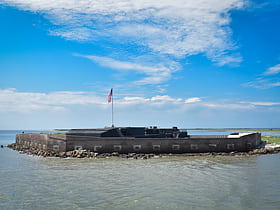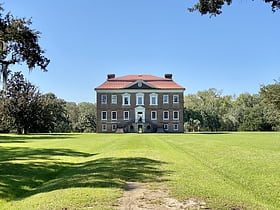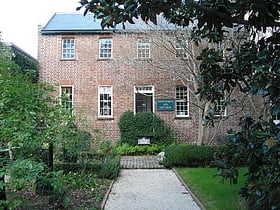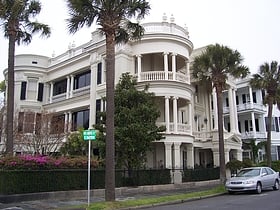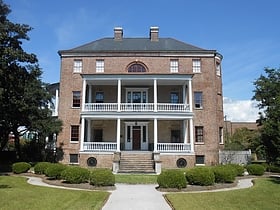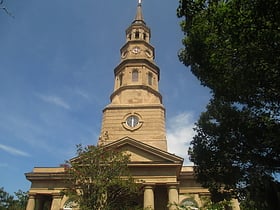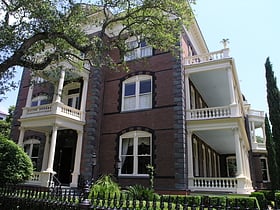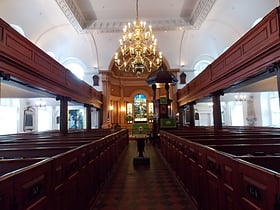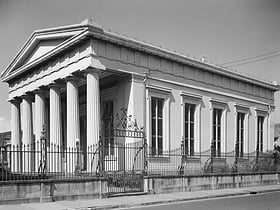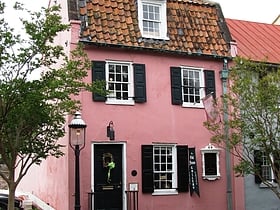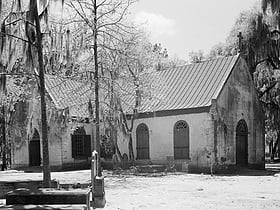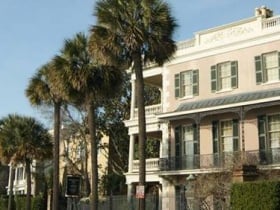Charleston: Historical Place
Places and attractions in the Historical place category
Categories
- Museum
- Park
- Church
- Historical place
- History museum
- Shopping
- Gothic Revival architecture
- Greek Revival architecture
- Sacred and religious sites
- Bridge
- Sport
- Sport venue
- Vernacular architecture
- Monuments and statues
- Shopping centre
- Concerts and shows
- Theater
- Art museum
- Art gallery
- Architecture
- Specialty museum
- Georgian architecture
- Cemetery
- Playground
- Concert hall
- Marina
- Sailing
- Neighbourhood
Fort Sumter
Sea fort with a pivotal Civil War role Fort Sumter stands as a testament to the resilience of the American spirit, located on an island in Charleston Harbor, South Carolina. This national park is not only a bastion of scenic beauty but also a significant landmark in United States history, marking the site...
Drayton Hall
Nestled on the banks of the Ashley River, Drayton Hall is a testament to the grandeur of 18th-century plantation life and a must-see museum for anyone visiting Charleston County, South Carolina. Built in 1738, Drayton Hall is an architectural marvel, renowned for being...
Nathaniel Russell House
The Nathaniel Russell House is a historic house at 51 Meeting Street in Charleston, South Carolina, United States. Built in 1808 by wealthy merchant and slave trader Nathaniel Russell, it is recognized as one of America's most important neoclassical houses.
The Battery
The Battery is a landmark defensive seawall and promenade in Charleston, South Carolina. Named for a civil-war coastal defense artillery battery at the site, it stretches along the lower shores of the Charleston peninsula, bordered by the Ashley and Cooper Rivers, which meet here to form Charleston harbor.
Joseph Manigault House
The Joseph Manigault House is a historic house museum in Charleston, South Carolina that is owned and operated by the Charleston Museum.
St. Philip's Church
St. Philip's Church is an historic church at 142 Church Street in Charleston, South Carolina. Its National Historic Landmark description states: "Built in 1836, this stuccoed brick church features an imposing tower designed in the Wren-Gibbs tradition.
USS Clamagore
Museum in a Cold War–era submarine USS Clamagore is a Balao-class submarine, presently a museum ship at the Patriot's Point Naval & Maritime Museum outside Charleston, South Carolina. Built in 1945 for the United States Navy, she was still in training when World War II ended. She was named for the clamagore.
Charleston Museum
The Charleston Museum is a museum located in the Wraggborough neighborhood in Charleston, South Carolina. It is one of the oldest museums in the United States. Its highly regarded collection includes historic artifacts, natural history, decorative arts and two historic Charleston houses.
Williams Mansion
The Williams Mansion is a Victorian house at 16 Meeting St. Charleston, South Carolina. The mansion is open for public tours.
St. Michael's Episcopal Church
St. Michael's Episcopal Church is a historic church and the oldest surviving religious structure in Charleston, South Carolina. It is located at Broad and Meeting streets on one of the Four Corners of Law, and represents ecclesiastical law. It was built in the 1750s by order of the South Carolina Assembly.
Powder Magazine
The Powder Magazine is a gunpowder magazine and museum at 79 Cumberland Street in Charleston, South Carolina, USA. Completed in 1713, it is the oldest surviving public building in the former Province of Carolina.
Charles Towne Landing
Charles Towne Landing State Historic Site in the West Ashley area of Charleston, South Carolina preserves the original site of the first permanent English settlement in Carolina.
Kahal Kadosh Beth Elohim
Kahal Kadosh Beth Elohim is a Reform Synagogue located in Charleston, South Carolina. Having founded the congregation in 1749, it was later claimed to be the first Reform synagogue located in the United States, the current 1841 synagogue was built by enslaved African descendants...
Heyward-Washington House
The Heyward-Washington House is a historic house museum at 87 Church Street in Charleston, South Carolina. Built in 1772, it was home to Thomas Heyward, Jr. a signer of the United States Declaration of Independence, and was where George Washington stayed during his 1791 visit to the city.
Gov. William Aiken House
The Gov. William Aiken House was built in 1820 at 48 Elizabeth Street, in the Wraggborough neighborhood of Charleston, South Carolina. Despite being known for its association with Gov. William Aiken, the house was built by John Robinson after he bought several lots in Mazyck-Wraggborough in 1817.
McLeod Plantation
McLeod Plantation is a former slave plantation located on James Island, South Carolina, near the intersection of Folly and Maybank roads at Wappoo Creek, which flows into the Ashley River.
Pink House
Pink House is a historic house and art gallery at 17 Chalmers Street in Charleston, South Carolina that is one of the oldest buildings in South Carolina and is the second oldest residence in Charleston after the Colonel William Rhett House.
Old Bethel United Methodist Church
Old Bethel United Methodist Church is located at 222 Calhoun Street, Charleston, South Carolina. It is the oldest Methodist church still standing in the city.
St. Andrew's Episcopal Church
Old St. Andrew's Parish Church is a historic church in Charleston, South Carolina. It is the oldest surviving church building in South Carolina. The parish was one of ten Anglican churches established by South Carolina's Church Act of 1706, and the original church was built the same year.
Thomas Elfe House
The Thomas Elfe house is a property located in the French Quarter at 54 Queen Street in Charleston, South Carolina. It was at one time owned by the well known colonial period furniture craftsman Thomas Elfe, whence its name.
Charleston County Courthouse
Charleston County Courthouse is a Neoclassical building in Charleston, South Carolina, designed by Irish architect James Hoban. It was a likely model for Hoban's most famous building, the U.S. White House, and both buildings are modeled after Leinster House, the current seat of the Irish Parliament in Dublin.
USS Laffey
USS Laffey is an Allen M. Sumner-class destroyer, which was constructed during World War II, laid down and launched in 1943, and commissioned in February 1944.
Map

